Serviços Personalizados
Journal
Artigo
Indicadores
-
 Citado por SciELO
Citado por SciELO -
 Acessos
Acessos
Links relacionados
-
 Similares em
SciELO
Similares em
SciELO
Compartilhar
Ingeniería, investigación y tecnología
versão On-line ISSN 2594-0732versão impressa ISSN 1405-7743
Ing. invest. y tecnol. vol.8 no.1 Ciudad de México Jan./Mar. 2007
Educación en ingeniería
A Performance Study of the IEEE 802.11g PHY and MAC Layers over Heterogeneous and Homogeneous WLANs
L. Villaseñor–González1, C. Portillo–Jiménez2 y J. Sánchez–García3
1 Electronics and Telecommunications Department CICESE Research Center, Ensenada, Baja California
E–mail: luisvi@cicese.mx
2 Electronics and Telecommunications Department CICESE Research Center, Ensenada, Baja California
E–mail: cportill@cicese.mx
3 Electronics and Telecommunications Department CICESE Research Center, Ensenada, Baja California
E–mail: jasan@cicese.mx
Recibido: enero de 2006
Aceptado: junio de 2006
Resumen
Las redes locales inalámbricas (WLANs) basadas en el estándar 802.11 se han extendido con mucho éxito dentro de una gran variedad de ambientes, incluyendo el hogar, las oficinas y las corporaciones. Iniciando con la introducción del estándar 802.11, a la fecha se han propuesto y aprobado diversas extensiones por la IEEE, éstas incluyen los estándares 802.11a, 802.11b y 802.11g. En este trabajo se presenta el análisis de desempeño de las capas físicas (PHY) y de control de acceso al medio (MAC) del estándar IEEE 802.11g. El estándar 802.11g opera en la banda de frecuencia de los 2.4 GHz y es compatible con el estándar 802.11b. Por lo tanto, resulta de gran interés presentar un estudio relacionado con el desempeño de las capas PHY y MAC que se utilizan en 802.11g, incluyendo el desempeño de los modos de operación de la capa física que fueron diseñados para preservar la compatibilidad con 802.11b (i.e. WLANs heterogéneas).
Descriptores: 802.11g, Protocolo MAC, análisis de desempeño, mecanismo de protección, RTS/CTS, WLAN.
Abstract
Wireless local area networks (WLANs) based on the 802.11 standard are being deployed with great success in a great variety of home, office and corporate environments. Since the introduction of the 802.11 standard, multiple extensions have been proposed and approved by the IEEE, namely the 802.11a, 802.11b and 802.11g standards. This work is related to the study and performance analysis of the IEEE 802.11g physical (PHY) and MAC layers. The 802.11g is defined to operate in the 2.4 GHz band and it was designed to preserve backward compatibility with the 802.11b standard. Hence it is important to present a study related to the performance of the MAC and the PHY operational modes in 802.11g, including the performance issues related to the PHY operational modes which are designed to be compatible with 802.11b (i.e. Heterogeneous WLANs).
Key words: 802.11g, MAC Protocol, Performance Analysis, Protection Mechanism, RTS/CTS, WLAN.
Introduction
Recent advances on wireless local area networks (WLAN) technologies are making possible the deployment of a large number of WLANs in a great variety of home, office and corporate environments. In particular, the success of the 802.11 standard has made it possible for a great number of products to be readily available at a large number of electronic retail stores. Since the initial introduction of the IEEE 802.11 standard, defined in (IEEE Std. 802.11–1999), several extensions have been approved by the IEEE. These extensions include the 802.11a (IEEE Std. 802.11a, 1999), 802.11b (IEEE Std. 802.11b, 1999) and 802.11g (IEEE Std. 802. 11g, 2003) versions.
The 802.11g standard defines the extensions to the medium access control (MAC) mechanism, as well as, the physical layer (PHY). One of the main characteristics of the 802.1 1g standard is that it defines a PHY layer operating in the 2.4 GHz band, thus allowing backward compatibility with legacy 802.11b equipment (Vassis et al., 2005). As a result, the 802.11g standard defines several PHY operational modes to support the compatibility with 802.11b (Choi et al, 2003). In addition, a protection mechanism is proposed in the 802.1 1g standard to avoid interoperability issues within a heterogeneous WLAN environment composed of 802.11b and 802.11g devices. Hence it is important to present a study on the performance of the 802.1 1g standard to have a clear understanding of the operational issues related to the multiple PHY operational modes, as well as, the implications or the impact introduced by the protection mechanism proposed in section 9.10 of (IEEE Std. 802.11g, 2003). There are a couple of articles in the literature that present some aspects of the performance of the 802.11g standard. Some related work includes the work by (Wang, S.–C. et al., 2005) which presents a mathematical model to evaluate the network throughput of 802.11g wireless networks; however they do not include a complete analysis of the multiple operational PHY modes defined in the 802.11g standard. (Wijesinha et al., 2005) present throughput performance of UDP traffic in a 802.1 1g wireless network, while (Medepalli et al., 2004) presents the call carrying capacity of 802.11 wireless networks including 802.11g; however they too fail to include a comprehensive performance evaluation of all the mandatory 802.11g extended data rates. (Boulmalf et al., 2005) presents the throughput and SNR measurements of an 802.11g wireless network for an indoor environment which includes the coexistence with 802.11b devices; however their work does not provide a detailed analysis of 802.11g by accounting for all the PHY and MAC layers functionalities implemented to support the coexistence with 802.11b and 802.11g devices. (Rao et al., 2005) investigates the performance of 802.1 1g through computer simulations using a realistic channel model for various modulation schemes, like BPSK, QPSK, 16–QAM and 64–QAM; however they only present Bit Error Rate (BER) results as a function of the channel SNR for the different supported modulation schemes. (Wang et al., 2005) present empirical network performance results for 802.1 1g networks and in their work they present packet delay, data loss and throughput measurement results as a function of the channel SNR; however they only consider an homogeneous 802.11g network environment and do not provide performance results for the backward compatibility operational modes of 802.11g. In an earlier work, (Doufexi et al., 2003) presents a performance comparison between 802.11a and 802.11g wireless networks and they describe some performance issues related to the interoperability of 802.11b and 802.1 1g devices; however they only provide performance analysis results as a function of the packet error rate PER. The main contribution of this work is to include a comprehensive performance study of all the mandatory operational modes of the 802.11g PHY layer, including the performance issues in heterogeneous 802.11b and 802.11g wireless networks.
This work is divided in five sections. The next section presents a description of the new features introduced in the IEEE 802.11g standard. Following we present a performance study and analysis of the 802.11g MAC protocol. Later, the numerical results are presented followed by the conclusions.
The 802.11g Standard
The IEEE 802.11g standard was approved on June 2003. This standard builds on the MAC protocol specifications defined for legacy 802.11 networks, as defined in (IEEE Std. 802.11–1999), (IEEE Std. 802.11a, 1999) and (IEEE Std. 802.11b, 1999). In addition, it also defines multiple operational modes for the PHY layer. This section presents a basic description of some of the MAC functionalities, as well as, the operational modes defined for the 802.1 1g PHY layer.
The 802.11 MAC Protocol
The 802.11 MAC defines two basic methods to access the medium, the Distributed Coordination Function (DCF) and the Point Coordination Function (PCF), as described in chapter 9 of (IEEE Std. 802.11–1999). The DCF defines a randomized access mechanism, which is based on the Carrier Sense Multiple Access /Collision Avoidance (CSMA/CA) scheme, where each mobile node has a fair chance to access the wireless medium. On the other hand, the PCF defines a centrally controlled access mechanism for the wireless medium. It should be noted that the 802.11 standard defines the PCF as an optional access method. The study and analysis presented in this work is based on the DCF access mechanism.
As part of the coordination procedure to gain access to the transmission medium, the 802.11 standard uses four different inter–frame spacing, section 9.2.3 of (IEEE Std. 802.11–1999). Figure 1 shows a diagram of the different Inter–Frame Spacing (IFS) used in 802.11. The Short Inter–Frame Space (SIFS) is used for the transmission of high priority 802.11 frames, such as, the Request–To–Send (RTS), Clear–To–Send (CTS ) and Acknowledgement (ACK) frames.
The PCF Inter–Frame Space (PIFS) is used during PCF contention–free operation. The DCF contention–based operation. An Extended Inter–Frame Space (EIFS), not shown, is also defined in the 802.11 standard and it is used when there is an error during a frame transmission. The Contention Window (CW) size is defined as a multiple of a time slot, and it plays a major role during the Backoff procedure that each mobile node must execute before transmission.
The use of the IFS and CW is important in the coordination of the access to the wireless medium, as described by (Gast, 2002). Table 1, shows the different inter–frame space values defined in the 802.11g standard which are defined in (IEEE Std. 802.11g, 2003). It should be noted that an optional time slot of 9 µs has been defined for those cases in which the wireless network is composed of only 802.1 1g complying devices, as indicated in section 19.4.4 of (IEEE Std. 802.11g, 2003).
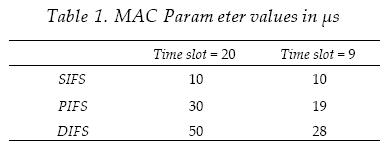
The minimum size of the CW, as defined in the 802.11g standard, is dependant on the requestor's characteristic rate. If the WLAN supports only rates in the set 1, 2, 5.5 and 11 Mbps, then the minimum size of the CW, denoted by CWmin, is equal to the length of 31 time slots, as defined in section 18.3.4 of (IEEE Std. 802.11b, 1999); otherwise, CWmin is set to be equal to the length of 15 time slots, as defined in section 19.8.4 of (IEEE Std. 802.11g, 2003).
The 802.11g PHY Layer
The 802.11g standard defines several rate extensions, as part of the Extended Rate PHY (ERP) specification, to the PHY for the Direct Sequence Spread Spectrum (DSSS) implementation. The 802.11g PHY specification includes four sets of modulation schemes ERP–DSSS/CCK (Mandatory), ERP–OFDM (Mandatory), ERP–PBCC (Optional) and DSSS–OFDM (Optional) (Vassis et al. 2005). Figure 2 shows the PHY layer PLCP–PDU (PPDU) packet format of the 802.11g ERP–DSSS/CCK PHY, from section 19.3.2.3 of (IEEE Std. 802.11g, 2003). The initial 802.11 standard (IEEE Std. 802.11–1999) defines a long preamble PLCP framing and later in standard (IEEE Std. 802.11b, 1999) a short (optional) preamble for the PPDU w as defined; however in the 802.1 1g standard the short preamble PPDU capability has been defined as mandatory.
Figure 3 shows the ERP–OFDM PHY layer PPDU packet format, which is the same as in 802.11a and it is illustrated in section 17.3.2 of (IEEE Std. 802.11a, 1999). An important observation should be made at this point; as part of the operational description of the ERP–OFDM modulation scheme, the 802.11g standard specifies that an ERP packet is going to be followed by a period of no transmission with a length of 6 µs. This period is called the signal extension. The logic behind this is that in the 802.11a standard the SIFS length is defined to be 16 µs, this is to allow for the convolutional decode process to finish, as it is described in section 19.3.2.3 of (IEEE Std. 802.11g, 2003). This assumption also applies to the ERP–OFDM in 802.11g, however in the 802.11g standard the SIFS length is defined to be 10 µs, presumably to preserve backward compatibility with 802.11b. Nonetheless, in 802.11g, the ERP–OFDM modulation scheme still requires 16 µs to ensure the convolutional decoding process to be finished on time. Therefore a signal extension of 6 µs is included so that the transmitting station can compute the Duration field in the MAC header. This will ensure that the NAV value of 802.11b stations is set correctly, as described in section 19.3.2.3 of (IEEE Std. 802.11g, 2003). The performance study presented in this work is based on the two mandatory ERP PHY specifications, namely the ERP–DSSS/CCK and the ERP–OFDM modulation scheme.
Protection Mechanism
The MAC sublayer functional description, presented in section 9 of (IEEE Std. 802.11g, 2003), includes a proposal to allow for the interoperability of 802.11b and 802.11g devices. The protection mechanism is introduced to ensure that 802.11g stations, using one of the ERP modulation schemes, do not transmit unless they have updated the Network Allocation Vector(NAV) of the receiving non–ERP stations, as described in section 9.10 of (IEEE Std. 802.11g, 2003). The protection mechanism proposes that ERP complying stations should transmit RTS/CTS or CTS–to–self frames before transmitting an ERP–OFDM packet. Figure 4, illustrates a time diagram to describe the RTS/CTS protection mechanism proposed in the 802.11g standard.
As indicated in section 9.2 of (IEEE Std. 802.11–1999), to support the proper operation of the RTS/CTS and the virtual carrier sense mechanisms, all the mobile stations in the WLAN shall be able to detect the RTS and CTS frames. As a result the RTS and the CTS frames shall be transmitted using one of the rates in the BSSBasicRateSet parameter. In addition, the 802.11g standard defines that if the protection mechanism is enabled and if the frame is a protection frame (i.e., RTS/CTS) then there are special rules for the transmission rate of these frames. In this case, if any of the rates in the BSSBasicRateSet parameter corresponds to an 802.11 or 802.11b rate, then the protection frames should be sent at one of the 802.11 or 802.11b basic rates, as described in section 9.10 of (IEEE Std. 802.11g, 2003). It should be noted that the protection mechanism is not required for the optional ERP–PBCC or DSSS–OFDM modulation schemes, as these frames start with a DSSS header which can be detected and processed by non–ERP (e.g. 802.11b) complying devices.
Performance Analysis
This section presents the methodology used in the performance study of the 802.1 1g standard. The analysis takes into account a variety of issues of the mandatory PHY operational modes defined in the 802.11g standard.
The performance study is divided in two scenarios:
1. The WLAN is composed by 802.11b and 802.11g devices (i.e., a heterogenenous WLAN).
2. The WLAN is composed of only 802.11g devices (i.e., a homogeneous WLAN).
The analysis presented in this section is focused on the upper bound performance that can be achieved at the MAC layer as a result of the framing structure and the overhead introduced at the MAC and PHY layers. In this work we are not concerned with the performance degradation due to network load and we only consider a scenario where a single station is transmitting data to another station, thus it is assumed that the station makes a successful transmission immediately after the CW period.
WLAN with 802.11b and 802.11g devices
In this scenario the WLAN is composed by 802.11b and 802.11g devices. Thus an 802.11g complying device can operate in any of the ERP–DSSS/CCK, ERP–OFDM mandatory modulation schemes. Recall that the 802.11b stations can detect ERP–DSSS/CCK PPDU packets. However, this is not the case when ERP–OFDM PPDU packets are transmitted by the 802.11g stations. In this case, the 802.11g devices must introduce the protection mechanism, described in (IEEE Std. 802.11g, 2003), or an alternative one as described by (Choi, 2003); this will ensure that the 802.11b devices will not transmit while the channel is busy.
The MAC throughput, MACth–DSSS, for the ERP–DSSS/CCK modulation scheme is defined in equation 1, while the MAC throughput, MACth–OFDM, for the ERP–OFDM scheme with protection mechanism (e.g., in a heterogeneous WLAN) is defined in equation 2,

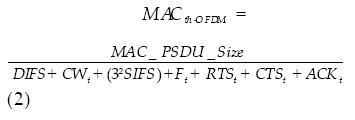
where, DIFS represents the DCF inter–frame spacing time, CWt is the average time length of the contention window, SIFS is the short inter–frame spacing time, Ft represents the time it takes to transmit the PPDU frame, RTSt, CTSt and ACKt represents the time it takes to transmit an RTS, CTS and ACK frame respectively. It should be noted that expressions (1) and (2) do not account for those cases where the MAC PSDU must be fragmented at the PLCP sublayer, in which case, each PPDU frame fragment is fallowed by a SIFS plus an ACK frame.
WLAN with only 802.11g devices
In this scenario the WLAN is entirely composed by 802.11g complying devices. In this case there is no requirement to use the RTS/CTS protection mechanism, other than to guarantee reservation of the wireless medium and to avoid the hidden node problem.
Figure 5, shows a time diagram of the transmission of an ERP–OFDM PPDU. In this case the MAC throughput is evaluated as indicated in expression (1).
Numerical Results
This section presents the numerical results of the MAC throughput for a heterogeneous and a homogeneous 802.11g wireless network. This section is divided in two subsections. The first subsection deals with a heterogeneous 802.11b and 802.11g wireless network scenario. The second subsection deals with a homogeneous 802.11g wireless network scenario.
Heterogeneous 802.11b and 802.11g WLAN
This section presents the performance analysis results of the MAC throughput for the two mandatory modulation schemes defined in the 802.11g standard, namely the ERP–DSSS/CCK and the ERP–OFDM modulation schemes.
ERP–DSSS/CCK Results
In this scenario the 802.11g complying devices transmit using the ERP –DSSS /CCK modulation scheme. As the non–802.11g complying devices can detect the ERP–DSSS/CCK messages, there is no need to introduce the RTS/CTS protection mechanism. Table 2 shows the MAC parameter values used for calculations in this section. The numerical results are presented for the case of short and long preambles.
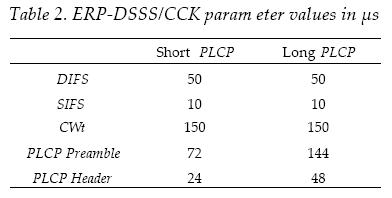
The average length of the contention window, CWt, is calculated as the expected value of a uniform random variable in the range [0, CWmin]. The value of CWmin increases with the number of retransmissions. It should be noted that the 802.11g standard defines an initial CWmin value of 15 time slots, while the maximum value of the contention window is limited by the physical layer. For the case of a direct sequence (DS) PHY Layer the maximum length of the contention windows is 1,023. For the purpose of the analysis presented in this section, the value of CWmin is 15 time slots and the time slot duration is equal to 20 µs.
The value of Ft, which represents the time it takes to transmit the PPDU frame, is defined as,

where, PLCPP and PLCPH represent the length of time required to transmit the PLCP preamble and the PLCP header, respectively. The MAC_PSDU_Size can have a maximum size of 2,346 bytes, which includes a variable size Frame Body of 0 – 2312 bytes and several control fields with a total length of 34 bytes (Heiskala et al., 2002). The set of PHY layer data rates, PHYrate, considered for this scenario include 1, 2, 5.5 and 11 Mbps.
Figure 6 shows the MAC performance results of the ERP–DSSS/CCK modulation scheme using the Long Preamble PLCP Framing format. The numerical results are presented for different lengths of the MPDU and at the four ERP–DSSS/CCK date rates: 1 Mbps, 2 Mbps, 5.5 Mbps and 11 Mbps. Figure 7, shows the MAC performance results assuming the Short Preamble PLCP framing format. The numerical results are presented for different lengths of the MPDU and at date rates of 2, 5.5 and 11 Mbps, which are supported with the short preamble framing format, as described in section 18.2.2.2 of (IEEE Std. 802.11b, 1999).
ERP–OFDM Results
In this scenario the 802.11g complying devices transmit using the ERP–OFDM modulation scheme. As the non–802.11g complying devices cannot detect the ERP–OFDM messages, there is a need to introduce the RTS/CTS protection mechanism. It should be noted that the RTS and CTS frames are transmitted at one of the basic rates defined in 802.11b. For the purpose of this work only the 2 Mbps and 11 Mbps basic rates of 802.11b are considered. In addition, the numerical results include the two possible cases in which the RTS/CTS frames are transmitted with a short or a long PLCP framing. Table 3 shows the MAC parameter values of the ERP–OFDM modulation scheme used for calculations in this section. The numerical results are presented assuming a time slot length of 20 µs.
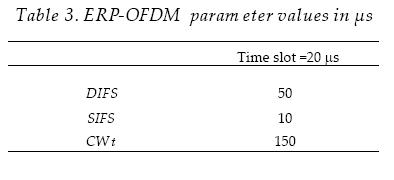
The average length of the contention window, CWt, is calculated as the expected value of a uniform random variable in the range [0, CWmin]. For the purpose of the analysis presented in this section, the value of CWmin is 15 time slots. It should be noted that the numerical results account for the extended service period of 6 µs after each ERP–OFDM PPDU frame transmission.
From the results presented in figure 8 to figure 11 (8, 9, 10, 11), it is clear that the MAC Throughput is not significantly affected by transmitting the RTS/CTS frames at 2 or 11 Mbps. This is explained by the fact that only the RTS/CTS frame body is transmitted at 2 or 11 Mbps and the RTS/CTS payload field is small. On the other hand, the use of a short or a long preamble has a greater impact on the MAC Throughput; this is especially true for high PPDU payload data rates.
Homogeneous 802.11 g WLAN
In this scenario the 802.11g complying devices transmit using the ERP–OFDM modulation scheme in an 802.11g homogeneous environment (i.e., the WLAN is composed only by 802.11g complying devices).
Then the 802.11g devices can transmit at any of the ERP–OFDM data rates without the need of an RTS/CTS protection scheme, unless there is a need for the reservation of the channel or to avoid the hidden node problem.
ERP–OFDM Results
The MAC performance results assume a time slot length of 9 µs, as described in (IEEE Std. 802.11g, 2003). The average length of the contention window, CWt, is calculated as the expected value of a uniform random variable in the range [0, CWmin]. For the purpose of the analysis presented in this section, the value of CWmin is 15 time slots. In addition, the MAC performance results account for the extended service period of 6 µs after each PPDU frame transmission.
Table 4 shows the MAC parameter values used for calculations in this section. The numerical results are presented assuming a time slot length of 9 µs.
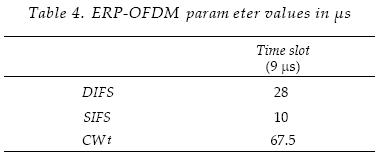
The results presented in figure 12 show an increased MAC Throughput, compared to the ERP–OFDM scheme in a heterogeneous WLAN. The MAC Throughput is almost twice in the ERP–OFDM in a homogeneous WLAN than that in a heterogeneous WLAN for a MPDU size of 2,346 and payload data rate of 54 Mbps. This result clearly indicates that the introduction of the RTS/CTS protection mechanism has a major impact on the performance of the ERP–OFDM modulation scheme, especially for high payload data rates.
Conclusions and Future Work
A performance study and analysis of the 802.11g MAC protocol is presented in this article. The most recent extension to the 802.11 standard, namely the 802.11g, defines multiple PHY operational modes. Some of these PHY operational modes are backward compatible with the 802.11b standard, while other PHY operational modes will require some sort of protection mechanism to allow for the interoperability of 802.11b and 802.11g devices within a heterogeneous WLAN, as described in (IEEE Std. 802.11g, 2003). In a heterogeneous WLAN an 802.11g complying device can operate using the ERP–DSSS/CCK or the ERP–OFDM modulation schemes. In general, a higher MAC efficiency is achieved under the ERP–DSSS/CCK modulation scheme. This result is explained by the fact that 802.11g complying devices must introduce the RTS/CTS protection mechanism when operating under the ERP–OFDM modulation scheme. On the other hand, in a homogeneous WLAN, the 802.11g devices can operate in the ERP–OFDM modulation scheme without the need of introducing the RTS/CTS protection mechanism, unless there is a need to guarantee the reservation of the wireless medium or to avoid the hidden node problem. In addition, in the case of a homogeneous WLAN, the CWmin size and the time slot length can be reduced, to 15 and 9 µs respectively, to allow for an improved MAC efficiency. Future work will consider the performance analysis of the 802.11g standard by accounting for the wireless network load and the impact that the wireless fading channel has on the transmission of 802.11g frames.
References
Boulmalf M., El–Sayed H., Soufyane A. (2005). Measured Throughput and SNR of IEEE 802.11g in a Small Enterprise Environment. The 61st IEEE Vehicular Technology Conference, Stockholm, Sweden, May. [ Links ]
Choi S., Del Prado–Pavon J. (2003). 802.11g CP: A solution for IEEE 802.11g and 802.11b Inter Working. The 57th IEEE Vehicular Technology Conference, Jeju, Korea, April. [ Links ]
Doufexi A., Armour S., Beng–Sin L., Nix A., Bull D. (2003). An Evaluation of the Performance of IEEE 802.11a and 802.11g Wireless Local Area Networks in a Corporate Office Environment. IEEE International Conference on Communications, Anchorage, United States, May. [ Links ]
Gast M.S. (2002). 802.11 Wireless Networks, The Definitive Guide. O'reilly & Associates Inc. United States, p. 29. [ Links ]
Heiskala J., Terry J. (2002). OFDM Wireless LANs: A Theoretical and Practical Guide. Sams Publishing, United States, p. 223. [ Links ]
IEEE Std. 802.11–1999. Part 11: Wireless LAN Medium Access Control (MAC) and Physical Laye (PHY) Specifications. Reference number ISO/IEC 8802–11:1999(E), IEEE Std. 802.11, 1999 Edition. [ Links ]
IEEE Std. 802.11a. Supplement to Part 11: Wireless LAN Medium Access Control (MAC) and Physical Layer (PHY) Specifications: High–speed Physical Layer in the 5 GHz Band, IEEE Std. 802.11a–1999. [ Links ]
IEEE Std. 802.11b. Supplement to Part 11: Wireless LAN Medium Access Control (MAC) and Physical Layer (PHY) Specifications: Higher–speed Physical Layer in the 2.4 GHz Band, IEEE Std. 802.11b–1999. [ Links ]
IEEE Std. 802.11g. Supplement to Part 11: Wireless LAN Medium Access Control (MAC) and Physical Layer (PHY) Specifications: Higher–speed Physical Layer Extensions in the 2.4 GHz Band, IEEE Std. 802.11g–2003. [ Links ]
Medepalli K., Gopalakrishnan P., Famolari D., Kodama T. (2004). Voice Capacity of IEEE 802.11b, 802.11a and 802.11g Wireless LANs. IEEE Global Telecommunications Conference (GLOBECOM), 2004, Dallas, Texas, United States, November. [ Links ]
Rao T.R., Giulietti A. (2005). A Performance Study on the 802.11g WLAN OFDM System. The International Conference on Computer as a Tool, Belgrade, Serbia & Montenegro,November. [ Links ]
Vassis D., Kormentzas G., Rouskas A., Maglogiannis I. (2005). The IEEE 802.11g Standard for High Data Rate WLANs. IEEE Network, Vol. 19, No. 3, pp. 21–26. [ Links ]
Wang S.C., Chen Y.M., Tsern–Huei L., Helmy A. (2005). Performance Evaluation for Hybrid IEEE 802.11b and 802.11g Wireless Networks. IEEE International Performance, Computing and Communications Conference, Phoenix, Arizona, United States, April. [ Links ]
Wang T., Refai H.H. (2005). Empirical Network Performance Analysis on IEEE 802.11g with Different Protocols and Signal to Noise Ratio Values. Second IFIP International Conference on Wireless and Optical Communications Networks, Dubai, United Arab Emirates, March. [ Links ]
Wijesinha A.L., Song Y., Krishnan M., Mathur V., Ahn J., Shyamasundar V. (2005). Throughput Measurements for UDP Traffic in an IEEE 802.11g WLAN. Sixth International Conference on Software Engineering, Artificial Intelligence, Networking and Parallel/Distributed Computing and First ACIS International Workshop on Self–Assembling Wireless Networks, Maryland, United States, May. [ Links ]
Author's biographies
Luis Villaseñor–González. Received an Engineering degree in Electronics from UABC, Mexico (1993); M. Sc. in Electronics and Telecommunications from CICESE, Mexico (1997); and Ph.D. in Electrical Engineering from the University of Ottawa, Canada (2002). He is currently a Research Associate Professor at the CICESE Research Center. He collaborated as a Network Research Engineer at the Communications Research Centre (CRC) in Ottawa, Canada. At CRC he was involved in a variety of research activities in network technologies for the Government of Canada between 1999 and 2003. His current research interests include mobile Ad–Hoc networks, wireless communications networks, QoS protocol architectures, performance analysis and evaluation of Internet technologies and computer networks. He is currently a member of the IEEE.
Canek Portillo–Jiménez. Received his M. Sc. in Electronics and Telecommunications from CICESE, Mexico (2004). He graduated from the Instituto Tecnologico de Culiacan with a B.Sc. in Electronics Engineering in 2002. His research interests include wireless LANs performance analysis and evaluation and OFDM systems.
Jaime Sánchez–García. Received an Engineering degree in Electronics from IPN–ESIME, México (1976); M.Sc. in Electronics and Telecommunications from CICESE Ensenada México (1979); and D.Sc. in Electrical Engineering (major in Communications) from The George Washington University (2001). Since 1979, he has a research and faculty position at the Electronics and Telecommunications Department CICESE. Dr. Sánchez spent nine months (1997) as Visiting Scholar at School of Engineering and Mines, University of Arizona Tucson. He won the 1st place in III Ericsson Yearly Award (1988), Teleindustria Ericsson México. His publications include several IEEE articles and international conferences. Current research interests include wireless networks, advanced modulation and access techniques, software radio, multipath propagation, and multicarrier modulation (OFDM). He is an IEEE member.














